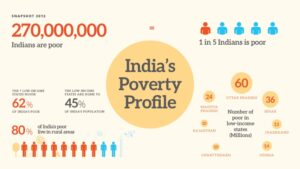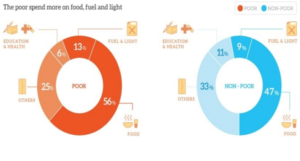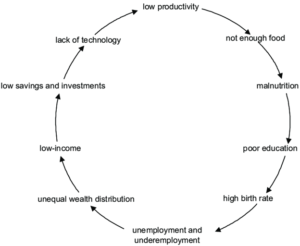consumption based poverty estimates have relevance.
Relevance:
GS Paper- 1: Poverty and developmental issues.
GS Paper-2: Issues relating to Poverty and Hunger.
Tags: #poverty #relativepoverty #absolutepoverty #hunger #endulkarcommittee #rangarajancommittee #worldbank #multidimensionalpovertyindex #consumptionbasedpoverty.
Why in news?
A report published by NITI Aayog on multidimensional poverty projected that the percentage of the poor has gone down from 25% in 201516 to 15% in 2019-21 and around 135 million people were lifted out of poverty during this period.
The Global Multidimensional Poverty Index report of 2023 of the United Nations Development Program (UNDP) and the Oxford Poverty & Human Development Initiative (OPHI), which was released recently, also shows that the incidence of the multidimensional poverty index declined from 27.5% in 201516 to 16.2% in 2019-21.
Comparison of methodologies of different poverty indices
- According to global multidimensional poverty index 2018- The incidence of Multidimensional poverty was almost halved between 2005/06 and 2015/16, climbing down to 27.5 per cent. Thus, within ten years, the number of poor people in India fell by more than 271 million — a truly massive gain”.
- According to Tendulkar committee methodology show (over a seven year period between 200405 and 201112) that the number of poor came down by 137 million despite an increase in population.
- According to the Rangarajan Committee methodology, the decline between 200910 and 201112 is 92 million, which is 46 million per annum.
The above stated data compared together to predict the lacunae present in the system of calculating poverty estimates as the poverty ratios based on the Tendulkar and Rangarajan Committee methodologies are lower than as estimated by global MPI.
Issues with these methodologies lies with the measurements of poverty estimates-
- According to Expert Group to Review the Methodology for Measuring Poverty (2014), these measures raise several issues regarding their measurability, aggregation across indicators, and, databases that provide information in limited time intervals.
- For example, there is a problem with the child mortality indicator as it is for population groups and not for households.
- Problem with aggregation: For different segment we should use different indicators, or we should use different indicators. Even in respect of independent indicators, analytically appropriate rules of aggregation require that all of them relate to the same household.
- We encounter issues with analyzing the progress of non-income indicators such as education, health, sanitation, drinking water, and child mortality over time with income or consumption poverty.
According to Deaton and Drèze (2014) “it is important to supplement expenditure-based poverty estimates with other indicators of living standards, relating for instance to nutrition, health, education and the quality of the environment”.
In the absence of such accurate indicators measurement system shows that several studies on poverty using indirect methods and using Centre for Monitoring Indian Economy (CMIE) and Periodic Labour Force Survey (PLFS) data sources have come up with differing conclusions.
Need for changes in survey-
The difference in India between the National Sample Survey and the National Academy of Science consumption is widening over time. Thus, there is a need to supplement the results of consumption surveys with a study of the impact of public expenditure on health and education of different expenditure classes.
Defining poverty in terms of income or in the absence of such data in terms of expenditure seems most appropriate, and it is this method which is
followed in most countries, and that is what we should adopt.
World Bank has developed poverty gap index as alternative way of measuring poverty. It measures the intensity of poverty, by calculating the amount of money required by a poor household in order to reach above the poverty line.
What is poverty?
World Bank Organization describes poverty as “Poverty is hunger”. Poverty is lack of shelter. Poverty is being sick and not being able to see a doctor. Poverty is not having access to school and not knowing how to read. Poverty is not having a job, is fear for the future, living one day at a time. Presently, the World Bank defines extreme poverty as living on less than $1.90 a day, measured in 2011 purchasing power parity prices.
Types of Poverty:
- Absolute Poverty – Absolute poverty refers to when a person or household does not have the minimum amount of income needed to meet the minimum living requirements
- Relative Poverty – It is a measure of income inequality. It is related to living standard of a person/family compared to the living standards of population in surroundings. Eg. In a surrounding where everyone has 4 cars, a person with 2 cars might be called as in relative poverty.
International Indices to measure Poverty
- World Bank defines poverty as deprivation in well-being comprising many dimensions. It includes low incomes and the inability to acquire the basic goods and services necessary for survival with dignity.
- Out of 17 Sustainable Development Goals (SDGs), to which India is committed, the first two are “ending poverty in all forms” and “hunger”. SDG1 is, by 2030 to reduce at least by half the proportion of men, women and children of all ages living in poverty in all its dimensions according to national definitions.
- This goal commits the signatories to eliminating poverty according to the common international poverty line of $1.25 per person per day (at 2005 Purchasing Power Parity or PPP) and cutting it in half “according to national definitions”.
- The UN’s 2030 Agenda for Sustainable Development reaffirmed the importance of multi-dimensional approaches to poverty eradication that go beyond economic deprivation.
Various international efforts to measure poverty along with implications for India are briefly discussed below:
Global Multi-Dimensional Poverty Index (MPI)
- MPI was developed in 2010 by the Oxford Poverty & Human Development Initiative (OPHI) and the United Nations Development Program.
- It uses different factors to determine poverty beyond income-based lists. It replaced the previous Human Poverty Index. The global MPI is released annually by OPHI.
- In Global MPI 2020, India was 62nd among 107 countries with an MPI score of 0.123
It tracks deprivation across three dimensions and 10 indicators as indicted below:
- Education: Years of schooling and child enrollment.
- Health: Child mortality and nutrition.
- Standard of living: Electricity, flooring, drinking water, sanitation, cooking fuel and assets.
Global Multi-Dimensional Poverty Index (MPI)
A person is multi-dimensionally poor if she/he is deprived in one third or more (means 33% or more) of the weighted ten indicators. Those who are deprived in one half or more of the weighted indicators are considered living in extreme multidimensional poverty. The MPI ranges from 0 to 1, higher values implying higher poverty.
Conclusion
Despite rapid growth and development, an unacceptably high proportion of our population continues to suffer from severe and multidimensional deprivation. Thus, a more comprehensive and inclusive approach is required to eradicate poverty in India.
Source: The Hindu.
Mains Question:
What do you mean by absolute and relative poverty. Discuss the issues pertaining to the measurement of poverty and suggest the recommendations given by C. Rangarajan and Tendulkar committees reports on poverty. (250 words)






